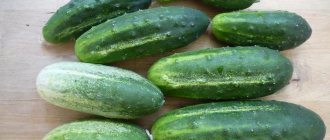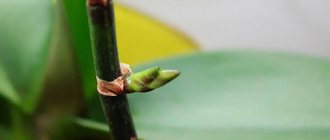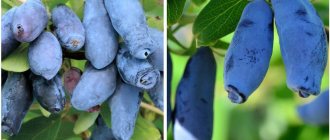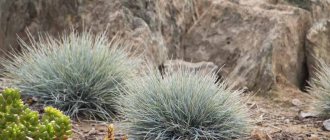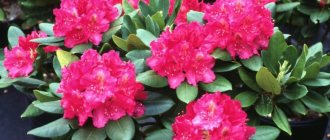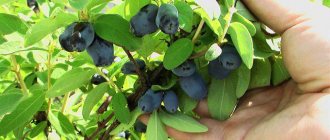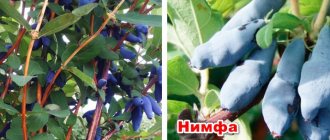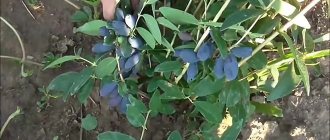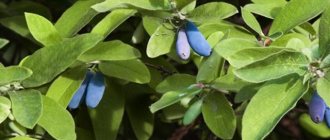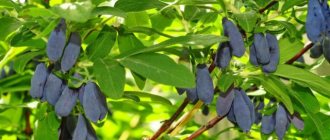History of selection
The Violet variety was obtained by workers of the Pavlovsk experimental station VIR (St. Petersburg) through open pollination of the Roxana variety. Its further tests and studies were carried out at the Krasnokutsk experimental station (Ukraine). The authors of the variety are Plekhanova M.N., Kondrikova A.V. and Kikbalo V.A. After state tests in 1995, the Violet variety first received regionalization in the North-Western region, and after a while - throughout the country. In Ukraine, the recommended areas for this honeysuckle are the northern regions.
Pests and diseases
Honeysuckle is very rarely attacked by pests. It is sometimes possible to encounter leaf roller caterpillars, aphids or scale insects.
It is best to use biologically active preparations to destroy pests that do not accumulate in fruits, do not harm human health and pets, and do not destroy insects that pollinate bushes. Most often, experts recommend the use of Fitoverm or Actofit.
Botanical description
Violet grows in medium-sized bushes about 1.3–1.5 m in height. They have a dense spherical crown and straight, slightly spreading branches of brown-green color. The flat leaves, shaped like an elongated oval, are colored green and are attached to the branches with short petioles.
The bushes winter well, are resistant to diseases and pests
The plant blooms with pale flowers no larger than 2 cm in size, there are 2 of them in inflorescences. From the end of May, fruits begin to ripen with an average weight of 1.14 g, but some specimens gain weight up to 1.5 g. They have a slightly curved shape of an elongated jug up to 1.2 cm thick and 2.8 cm long.
The fruits have a slightly lumpy surface and a thin, strong, blue-violet skin with a light waxy coating . Their pulp is fibrous, good density, sweet and sour taste and a faint pleasant aroma. Tasters rated this taste at 4.3–5 points.
Did you know? Violet honeysuckle pulp in 100 g contains a lot of ascorbic acid (69.2 mg) and P-active substances (637.2 mg). This makes the consumption of its fruits an excellent prevention of cardiovascular diseases and increases the body's defenses.
Reviews of the honeysuckle variety Violet
Reviews generally confirm all the advantages of Violet honeysuckle. There is also a small clarification regarding unpretentiousness. It is argued that if it is not possible to frequently water the bush and care for it, you can lay mulch around the trunk - this will protect against weeds and retain the moisture necessary for the plant.
Where can I buy
You can buy Violet honeysuckle seedlings in our online store. We ship orders throughout the country using Russian Post and TK. To order Violet honeysuckle seedlings, follow the link.
Previous:
- Russian persimmon: variety description, reviews, characteristics
- Phlox subulate: description of the variety, reviews, characteristics
- Plum Burbank Giant: variety description, reviews, characteristics
- Columnar plum Fortuna: variety description, reviews, characteristics
- In vitro technology
Characteristic
Violet honeysuckle has high winter hardiness and an average yield.
Frost resistance and drought resistance
The variety has high winter hardiness and winters well in the central zone of the Russian Federation. Return frosts in spring do not damage it.
Fruiting, productivity
The variety is early-bearing and begins to bear fruit 3-4 years after the seedling is planted. The yield of the bush is no more than 1.8 kg. The ripening time of berries depends on the growing area. In Ukraine, berries can be picked from the end of May, and in the Moscow region - from the end of June.
Advantages and disadvantages
- Gardeners are attracted to the honeysuckle variety Violet by the following characteristics:
- excellent taste;
- high content of ascorbic acid and other trace elements;
- ability to be easily transported;
- keeping quality;
- versatility of using berries;
- high resistance to frost, diseases and pests;
- the ability to form decorative fences.
The disadvantages of this variety include the need for cross-pollination with other varieties.
Honeysuckle fruit
Tasters rated the taste of the aromatic berries of the Violet variety at 4.7 points out of 5 possible.
Rose tree - features of growing a standard flower
The shape of the fruit resembles a jug. Their surface is slightly bumpy, the skin is thin but dense. The color of the berries is blue-violet, the taste is sweet and sour, with a pleasant aroma.
What are the benefits of berries and how are they used?
The fruits contain a large amount of nutrients. They help increase immunity, strengthen the walls of blood vessels, lower blood pressure, and remove heavy metal salts.
The berries are consumed fresh; jams, compotes, and jelly are made from them. The fruits are added to salads, mousses and cocktails are prepared from them. In addition, the berries are dried and frozen.
Note! Honeysuckle has laxative properties, so it is not recommended to consume more than 100 grams of berries per day.
Harvesting
The ripening of honeysuckle fruits occurs unevenly. The berries below begin to sing earlier. Therefore, harvesting is done gradually. The procedure is performed in dry weather.
The fruits of honeysuckle violet have beneficial properties
Landing Features
The main thing when choosing a place for Violet honeysuckle is not to forget about the need to plant pollinators nearby.
Deadlines
Honeysuckle begins to flow early sap in the spring, so autumn planting is preferable. Young seedlings can be planted from late summer to early November, depending on the climate . The plant overwinters well, but must take root before cold weather.
Honeysuckle in a container can be planted throughout the growing season, and in the spring too.
Video: Planting and caring for honeysuckle
Selecting a site, preparing holes
You need to carefully choose a site for planting honeysuckle, because it grows in the same place for about 25 years. The place for this berry bush should be well lit by the sun . It should be enough to plant several seedlings. It is not necessary to create a berry garden - this honeysuckle can be used in landscape design.
The soil at the planting site is preferably loose and nutritious with a neutral reaction. Groundwater level - no closer than 1.5 m
In 2–3 weeks, planting holes with a diameter of 0.5 m and a depth of 0.3–0.4 m are dug. When digging, the top layer is placed separately, then mixed with organic matter (humus or rotted manure, peat). It is also good to add phosphorus-potassium fertilizers. If necessary, lime the soil . For looseness, sand and ash should be added.
Important! If the bark of a honeysuckle seedling peels off a little, do not be alarmed: this is a feature of the culture.
Selection and preparation of planting material
It is better to buy seedlings from a specialized nursery or from reliable sellers. You should immediately purchase several varieties. The best choice would be to buy honeysuckle with the following parameters:
- biennial plant with 2-3 branches;
- about 30–40 cm high;
- there should be buds on the branches;
- the roots must be moistened, “alive” when cut;
- without damage or signs of disease.
Planting scheme
When planting seedlings, the following steps are performed:
- Before planting, the hole can be poured with boiling water.
- The plant is placed in the hole and, if necessary, the soil mixture is added.
- Then straighten the roots of the seedling and carefully cover them with nutritious soil. The root collar is buried into the ground at least 3–5 cm.
- The soil is compacted from above and a hole is formed.
- The planting is well moistened.
Honeysuckle bushes are placed at a distance of 1 m from the plants in a row, with row spacing of 2 m.
Agrotechnics of cultivation
Selecting a location
Honeysuckle needs to be planted in a place in the area where it will have enough sunlight; without it, fruiting will be sluggish. The culture does not like swampy areas, places where groundwater is close to it, as the roots immediately begin to rot. Also keep in mind that honeysuckle is a perennial, it needs pollinating neighbors, we have already talked about them earlier. So keep this in mind when choosing a location to ensure your garden looks organic in the future.
Soil preparation and planting dates
It is optimal to plant honeysuckle “Violet” in the fall; it is not afraid of frost, so this can be done almost until December. But in the spring, the crop begins to flow sap early, so it is better not to carry out all the manipulations of planting and replanting, otherwise the bushes will take a very long time to take root and get sick. Honeysuckle loves neutral soil that allows air to pass through well. To do this, add ash and sand into the hole.
As experience has shown, it is better to choose organic fertilizers for crops - manure, compost, mullein, humus. Therefore, in addition to sand and ash, which will reduce acidity, if any, you can add one third of the listed fertilizers into the hole. Also, before planting, it is better to pour boiling water on the area under the honeysuckle 3-4 days before planting, because many parasites, bacteria and viruses could accumulate here during the season.
Advice! Do not plant the shrub too late if you experience cold weather early so that it has time to take root. Planting dates can be seen in the lunar calendar for gardeners.
Planting and care
So, the site has been selected for the edible honeysuckle “Violet” and prepared, and you have also stocked up on pollinating varieties. It's time to plant - dig holes so that the seedlings fit freely in them, at a distance of 1.5 meters from each other. While straightening the roots, cover with soil, but make sure the root collar is on the surface. Water with warm water, lay a layer of straw mulch around the trunk to conserve moisture and heat, and the seedlings will take root faster. The soil should not dry out.
In the spring, when the snow melts, you need to pour nitrogen fertilizer under the bush - a tablespoon of urea per bucket of water. The mulch must either be removed or replaced with a new one. The bushes are moistened as they dry out and always loosened after watering. If the soil is acidic, then once a season pour a bucket of water with a liter of ash. The next feeding is applied at the end of spring - a bucket of compost or humus, and then in the fall - again organic matter plus 40 grams of superphosphate.
Important! In the first and second years, it is better not to feed the honeysuckle with fertilizers; what was added to the hole will be enough for it. It is better to start feeding regularly at the end of the second year of life and so on.
Pruning and pests
We have already said in the description of the honeysuckle variety “Violet” that insects rarely bother it. But if, nevertheless, aphids, leaf rollers, scale insects or caterpillars have settled on the plantings, then they are removed with such preparations as Lepidotsid, Fitoverm, Aktofit, Iskra-bio, Bicol. But do not use them during fruiting or even during flowering. During this period, it is better to make do with folk infusions of weeds, aromatic herbs, onion peels, garlic and pepper. These are safe methods for health.
As for pruning, in the fall all the old parts are removed, in the spring those that have not overwintered well, as well as all the shoots that grow inside the bush. It is also worth noting that honeysuckle is not shortened during planting, as can be done with other crops. When the bushes have reached the age of six years, they form a crown, and this is done every 2-3 years. Additionally, they get rid of all the old, lower branches that no longer produce a harvest. Over-aged bushes begin to bear fruit poorly and are rejuvenated with the help of radical pruning. All procedures are best carried out in the evening in cool weather.
We told you all the important techniques, secrets of growing, and also told you about the great benefits of honeysuckle. If you have a garden plot, be sure to plant this shrub on it.
Rules of care
It should be noted that the crop does not like excess moisture and mineral fertilizers. Watering should be done moderately - in hot weather, 10 liters of water is enough for the bush. During rains, watering is stopped. Despite the fact that honeysuckle does not react well to excess moisture, the soil around the bushes should not be dry.
After moistening, it is recommended to loosen the soil and remove weeds . This will improve the supply of oxygen, nutrients, and moisture to the roots of the plant crop. To make maintenance easier, it is better to mulch the soil around the bushes, which will protect the soil from drying out and prevent the growth of weeds.
At least once a season you need to water with the addition of wood ash (1 liter of ash per 10 liters of water). This procedure will reduce the acid level in the soil
It is also necessary to apply fertilizers that contain all the necessary nutrients. For the first two years after planting, you don’t have to fertilize the soil, since enough useful elements were added during planting.
In the third year, it is recommended to carry out the following feeding:
- In early spring, nitrogen-containing fertilizers are applied to the soil to increase green mass. You can use urea (1 tablespoon per 10 liters of liquid).
- In May, organic matter is added - humus (1 bucket for one plant), rotted manure or bird droppings.
- In autumn, organic ingredients are also used. For bush 2, take 1/2 a bucket of humus and add 40 g of superphosphate.
It is also necessary to prune the bushes. In the fall, pruning is carried out for sanitary purposes - dried, damaged branches and branches growing inward are removed.
Honeysuckle seedlings cannot be shortened, as this will delay the fruiting process . You should not cut off the tops of the bushes, since it is on them that the fruits form. The crown of an overgrown bush is formed at the age of 6 years. Then anti-aging pruning is carried out every 2-3 years. In addition to removing dry and damaged branches, lower branches that no longer bear fruit are cut off. As a rule, about 5 main branches are left.
Bushes over 20 years old require significant anti-aging pruning. Gradually over several years, trunks that do not bear fruit or bear fruit very poorly should be removed.
Tips for growing and caring for honeysuckle
- It is recommended to plant honeysuckle in the fall, before it gets significantly colder. It is not worth planting plants in the spring, since sap flow begins early and they will take a very long time to take root.
- The “Violet” variety loves to be fertilized with organic fertilizers. This can be humus, liquid fertilizer from mullein, or bird droppings.
- A few days before planting, the honeysuckle bush should be doused with boiling water. This will kill various parasites and bacteria that may live on the plant.
- Bushes should be planted at a distance of one and a half meters from each other. The hole is dug in accordance with the size of the root system. Humus, sand, and rotted sawdust are added to the removed soil. A seedling is placed in the hole, the roots are straightened, and covered with the resulting soil mixture. The soil under the plant is compacted and watered with warm water (2 buckets). The soil around the bush needs to be mulched to reduce moisture evaporation and also retain heat.
- In the spring, after the snow has melted, nitrogen-containing fertilizer should be applied to the plants. It is prepared very simply; 20 grams of saltpeter are dissolved in a ten-liter bucket of warm water and watered 5 liters per bush.
- In the spring, the mulch must be completely removed or replaced with a new one.
- Plants need to be watered once a week until they begin to grow.
- Honeysuckle needs to be fed in the spring during fruit set and in the fall before frost. A bush will require one bucket of rotted manure or forty grams of superphosphate.
- Plants can be pruned in late autumn or early spring, when sap flow has not yet begun. Remove shoots that grow inward, dry branches, old branches.
- Honeysuckle is extremely rarely attacked by pests, but if caterpillars, aphids, and leaf rollers suddenly settle on the bushes, then they can be destroyed using the preparations “Aktofit” and “Bikol”. It is not recommended to use the preparations during flowering, formation and ripening of fruits.
Harvesting and storage
You can start harvesting from the end of May. Berries will appear on the side shoots, inside the bush. Ripening is uneven - fruits appear later from below than from above. They are picked as they ripen.
The fruits are not stored for a long time: they can stay on the refrigerator shelf for no more than 2–3 days. Honeysuckle berries are suitable for processing - they are used to make delicious wine and jam. These fruits can also be frozen or dried, but they are best eaten fresh.
You can pick the fruits by hand. Another way is to place an agrofibre plant under the bush and then shake the bush - the ripe berries will fall off
Description of the honeysuckle variety Violet
Honeysuckle Violet is a variety of unpretentious fruit honeysuckle recommended for planting in all regions of Russia. As you know, honeysuckle was originally used to decorate homestead interiors and in landscape design. Varieties with edible fruits began to be developed relatively recently.
Violet honeysuckle berries are very healthy and tasty. They do not fall off the bush after ripening, which is very convenient for collecting. Moreover, ripe honeysuckle fruits tolerate transportation well and are stored for a long time. They are universal in use - they can be eaten both fresh and processed. Let’s add to the characteristics of the berries the high decorative properties of the bush itself (especially the flowering one), as well as the plant’s resistance to cold, and we will get a complete picture of this wonderful culture in all respects.
Reproduction methods
To propagate Violet honeysuckle, it is best to use the following methods:
- Dividing the bush . The most common and simplest method. It is produced when the bush has already grown and gives adventitious roots during hilling. The plant is dug up in the off-season and divided into several parts. Each part is then planted as a separate seedling. The survival rate of such planting material is very high.
- By layering . In this case, honeysuckle shoots are used, which grow at an angle to the ground. Such annual shoots are pressed to the soil in early spring, then the tops are pinched and dug in. By autumn, the cuttings form their own root system. They are separated and placed in a permanent place.
- By cuttings . In this case, young shoots should be used. The cuttings must be at least 20 cm long and have 2-3 buds. They are rooted by creating greenhouse conditions or using ordinary pots for indoor flowers.
When and how does honeysuckle bloom?
Dutch roses - varieties, growing features
Honeysuckle variety Violet is characterized by early flowering and fruit ripening.
- Flower shape
On the shoots of Violet, 2-centimeter five-petal flowers are formed. During the formation period, they are painted with a pale green palette. During complete dissolution, the color changes to white.
- Flowering period
The plant blooms in May. In late spring or early summer, oblong fruits of blue-violet color are formed.
Benefit of the berry
Wild berries have a number of undeniable advantages:
- Excellent winter hardiness. For most varieties, temperatures of 50 degrees below zero are not a threat. Even if plants have been damaged by frost, they tend to recover quickly. Moreover, they delight with tasty and aromatic fruits, while other shrubs lose almost their entire harvest.
- Duration of fruiting. This is one of the most fruitful shrubs. The long life span allows it to bear fruit for 25-30 years.
- The honeysuckle harvest is always in demand in any market. Even from the smallest plot of land you can collect a lot of berries.
- Honeysuckle fruits ripen very quickly. Honeysuckle is a fast-growing crop. Some varieties can produce fruits in the first year after transplantation.
- The fruits can be collected at a time when strawberries and raspberries are just beginning to bloom.
Honeysuckle is accessible to any summer resident. Almost all varieties are very resistant to pests and many diseases. Doesn't require any special care. There is no need to treat the shrub with various chemicals. The fruits can be consumed even by small children.
Advantages and disadvantages
Honeysuckle Violet is woven from advantages; there are no significant shortcomings in the description of the variety. Its main advantages:
- frost resistance;
- not fussy to care for;
- rare diseases;
- a small list of pests;
- transported easily and without loss;
- bears fruit well;
- the berries are large, with excellent taste characteristics;
- does not crumble when ripe.
Honeysuckle, in addition to all the listed advantages, also has valuable medicinal qualities, in particular, ascorbic acid in its composition will help to significantly improve immunity.
Sources:
https://sortoved.ru/zhimolost/sort-zhimolosti-fialka.html https://mirogorodov.ru/zhimolost-fialka.html https://agronomu.com/bok/4617-harakteristiki-i-osobennosti-vyraschivaniya- zhimolosti-fialka.html
The unique honeysuckle berry and its benefits for our health
We often grow something without asking ourselves what exactly the crop gives us, other than nutrition. We know that plant products are useful, but what they are not. But you need to broaden your horizons, and then you will see how many benefits there are in the fruits of honeysuckle. Of course, all this is thanks to the healing composition, which contains vitamins - A C, P, PP, group B, macro- and microelements - copper, manganese, barium, sodium, silicon, iodine, calcium, potassium, iron, magnesium, and also a lot of pectin , phenolic substances, acids, fructose,
Thanks to their composition, honeysuckle “Violet” and a number of other varieties benefit the body.
- Normalizes the functioning of the gastrointestinal tract, genitourinary and cardiovascular systems.
- Improves vision.
- Boosts immunity and protects during cold season.
- The berry is necessary for those people who live in environmentally unfavorable regions.
- Helps with skin ailments, oral diseases, stomach and intestinal disorders.
- Metabolism improves, honeysuckle helps expel waste and toxins, which also has a beneficial effect on weight loss.
- Helps with high blood pressure and weak blood vessels.
On a note! Honeysuckle fruits, depending on the variety, contain only 30-40 kcal per 100 grams.
